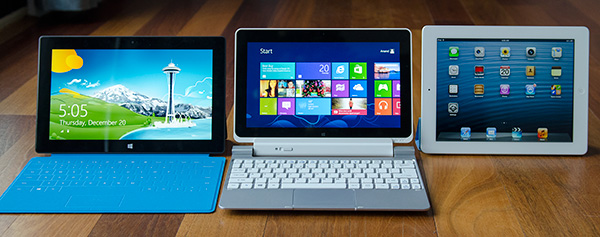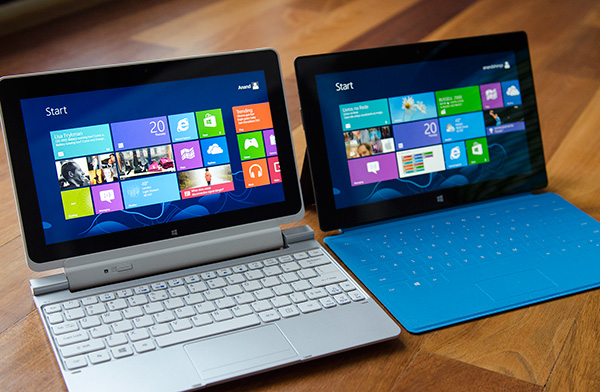The Clover Trail (Atom Z2760) Review: Acer's W510 Tested
by Anand Lal Shimpi on December 20, 2012 10:34 AM ESTFinal Words
This is a tricky conclusion to write, because as always there’s a lot of concluding that has to be done. On the one hand, we have Intel’s Clover Trail platform. On the other we have Acer’s Iconia W510 tablet itself. And on a magical third hand we have to conclude on behalf of Microsoft’s Windows 8.
I’ll start with the Intel hand.
Clover Trail is good. I only have NVIDIA’s Tegra 3 to compare it to at this point, and there Intel wins hands down. Performance is clearly better, tasks complete quicker, the modern UI is even more responsive. Power efficiency, once again, seems like a non-issue. The W510 in particular uses a smaller battery than most, but its battery life per watt-hour is very similar to Surface RT. Samsung’s ATIV Smart PC actually seems to be a better showcase of what Clover Trail can do from a power efficiency standpoint. If we haven’t squashed the notion of Intel being unable to build low power SoCs by now, Clover Trail should help drive the nail into that coffin. The debate is no longer about whether or not Intel can build something competitive with ARM on the power front, but whether Intel can execute quickly enough to defend its marketshare.
Backwards compatibility is a hit or miss advantage for Clover Trail. If you use it for the flexibility of being able to run nearly every Windows application available, then you’ll be pleased. Small apps that I’ve relied on for years just run without issue on Clover Trail. I don’t need to find modern replacements, my library of tools just work. I suspect this advantage will appeal in enterprise markets where custom applications are often on very long development cycles.
However if you’re expecting to be able to enjoy a similar experience to what you currently have on your Ultrabook, you’ll be sorely disappointed. Atom isn’t Core, the performance delta is dramatic. The Windows 8 desktop experience on Clover Trail is like using a notebook from several years ago. Performance is at least consistent thanks to the lack of any mechanical storage, but running intense workloads on the platform is hardly quick. Being quicker than most of the ARM platforms on the market today isn’t enough, Intel has to deliver a good experience across all applications. The experience is further hampered by sub-par UI performance in desktop mode. It actually feels like Tegra 3/Surface RT are faster when it comes to desktop UI performance. This highlights a disturbing trend within Intel’s ultra mobile products. The company continues to under-spec its ultra mobile GPUs. If Intel is really serious about both the tablet and smartphone markets it needs to build the best SoCs in the world, and that means delivering the best CPU and GPU performance.
I was impressed by the unique combination of closed box tablet OS and flexible/customizable desktop OS that Windows RT delivered. Windows 8 on Clover Trail takes that feeling to a completely new level. Being able to install and run nearly any weird, old application in one breath and then switch over to a fairly well optimized tablet experience in the next is pretty awesome. Where the experience falls short is really the performance of desktop mode and most of the applications I’d like to run unfortunately. Scrolling isn’t smooth, response time is pretty bad if you’re running anything demanding. You have to keep in mind that, at best, we’re talking about mainstream notebook CPU performance from around 2005. Until Intel revs Atom (which should happen next year, thankfully enough), the backwards compatibility story won’t be as awesome as it could be.
On the Acer side of things, the dock experience (particularly the troubles I had with the clickpad) also contributes to the W510 not being the perfect tablet+notebook in one. As a standalone tablet I prefer the W510, it’s got a great form factor and I love its light weight. As a docked system however, Samsung’s ATIV Smart PC seems to be the better choice.
The W510 itself is well executed, but overall the experience seemed a bit less polished than with Microsoft’s Surface RT. This is where things get really complicated. I want the SoC from the W510 but in the overall device experience that Microsoft’s Surface delivered. I even think Acer might have a form factor advantage in the W510 since it’s just so light. It’s a shame that the only x86 Surface device will be the bigger Pro model.
Ultimately my conclusion about the W510 in particular is a lot like what I felt about Surface RT. You know it’s going to be made obsolete in less than a year’s time, so you have to be ok with that fact if you’re going to pull the trigger today. Even then, the experience isn’t perfect. Microsoft still needs some updating on the Windows side to address bugs and quirks with the OS. Performance isn’t as big of a problem on the W510 as it was on Surface RT, but I’d still like to see more on that front as well.
Much of the same goes for Windows 8. Although its execution hasn’t been perfect, I really do like the OS and I see a lot of potential in these converged notebook/tablet devices. Especially for users who travel a lot, being able to have the best of both worlds in an extremely portable device is a wonderful dream. I think Microsoft has the right vision, but what we need to see are more revs to the OS to fully realize it. The real question is whether or not Microsoft will be able to deliver significant updates to Windows 8 as quickly as the market needs it.













104 Comments
View All Comments
BSMonitor - Thursday, December 20, 2012 - link
ExactlyNot everyone runs only prepackaged software from Best Buy.
I can write programs in Visual Studio very easily on the PC. With no recompiles, emulators, etc, I can also run that program on the x86 tablets.
Guspaz - Thursday, December 20, 2012 - link
That has nothing to do with x86 compatibility and everything to do with Win32 compatibility, and that's all on Microsoft.If Microsoft had not prevented third-party apps from using Win32 on RT devices, you'd be able to recompile most apps with no code changes for ARM.
Alexvrb - Thursday, December 20, 2012 - link
Well that would be nice for us tech heads, but opening up WinRT like Win8 brings all of the negatives too. For most of your average users, WinRT is better. You can't take it online, click some ads, and get a nice trojan or two. It's really a good tablet platform overall.So now we've got the option of some affordable Atom-based Win8 tablets. So you can pick whatever suits your needs more, WinRT (and its restrictive walls and safety) or Win8 (and all the traditional Windows advantages and disadvantages).
Chamie - Tuesday, March 5, 2013 - link
> You can't take it onlineYou can stop here, lol. (No browsers, only IE) Kidding.
But, actually, you can't get it as easy on x86 Windows too — UAC and other stuff should prevent it. The only thing preventing you from getting the same on RT will be it's lack of popularity for users and, thus, for malware makers. Even WiFi routers suffer from infections (see Psyb0t, Chuck Norris etc.) despite running Linux on MIPS, why would Windows on ARM be any safer?
Guspaz - Thursday, December 20, 2012 - link
Every single app you mentioned there runs on ARM (either the full version or a mobile tablet-oriented version) except for notepad++, and the only reason it won't run on ARM is because Microsoft forbids the use of Win32 on RT.x86 compatibility isn't all its cracked up to be. Most of the software you use on an x86 Linux distribution works just fine on an ARM Linux distribution, including stuff people tend to use on a day to day basis like Chrome or Firefox.
I think you could make a better case for Win32 compatibility, x86 compatibility doesn't mean much for most people.
SM123456 - Wednesday, February 13, 2013 - link
But this netbook costs $600. Ridiculous!Concillian - Thursday, December 20, 2012 - link
Depends entirely on what you want to run.Consider, for example automotive applications that interface with your car. These are very lightweight and old tech. A laptop in the passenger seat with a TN screen is overly bulky and the crappy screen is a liability. A tablet is a huge improvement in ergonomics.
Applications like that are NEVER getting ported to android or iOS, so x86 compatibility is the only answer. I suspect that there are a number of similar industrial applications. At my work, we have some very lightweight applications at work running homemade VB or .Net applicatoins from 1.6GHz P4 machines. With x86, we could run them, but nothing else will. Some of these were developed to run on a 486 and we still use the basic program to run the equipment.
x86 compatibility is meaningful to people who do actual work with these kinds of devices. Those who treat them like toys? Probably not so much.
Slaimus - Thursday, December 20, 2012 - link
There are many such apps for iOS and Android. They interface with a bluetooth OBD transmitter and you can wirelessly view real time information. See: https://play.google.com/store/apps/details?id=org....Concillian - Thursday, December 20, 2012 - link
I know of and have used Torque. It's a toy.It cannot do the same thing that factory diagnostic tools and open source reverse engineered equivalent tools can do (like re-programming the ECU or TCU for your desires). Those tools are specialized by vehicle brand and are (x86) Windows exclusive.
Industrial applications for these kinds of things move at a GLACIAL pace. Less than a decade ago I was regularly using a program that used a *terminal program* to communicate through a serial cable to program the device... It was straight out of the 80s... iOS and Android apps for the stuff that people make money with are not going to spring up overnight.
x86 compatibility is a must for these kinds of applications. They also happen to be applications that are VERY light on hardware, so these kinds of tablets are a good option.
lmcd - Thursday, December 20, 2012 - link
I'm sorry, but you attribute "actually doing work" to "requiring junky legacy apps?" Not every workplace is burdened with those. And most that are depend on the mouse+keyboard interface anyway, so the whole "Win 32' compatibility is irrelevant.Besides, why did you write homemade VB apps anyway? VB is VB... and .Net shouldn't be that hard to port to a new version (which, obviously, would run on RT).